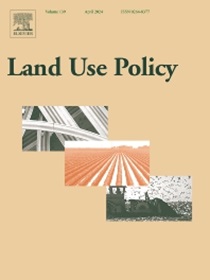The smart city competitiveness index (SMCI): Conceptualization, modelling, application – An evidence-based insight
IF 6
1区 社会学
Q1 ENVIRONMENTAL STUDIES
引用次数: 0
Abstract
At the core of the discussion in this paper lies the recognition that information and communication technology (ICT) and ICT-enhanced tools, applications, as well as elements of built environment (BE), specific to and defining the smart city, have considerable potential to facilitate economic exchange in the geographically limited smart city space. In this way, they contribute to the enhancement of competitiveness and economic growth, thus also improving the efficiency of land use. Still, relatively little has been written about smart cities’ economic performance, especially not through the lens of competitiveness and land use policy. This paper addresses this issue by conceptualizing and modelling the connection between ICT-enhanced applications, services and infrastructure, built environment and smart city competitiveness. A model composite smart city competitiveness index (SMCI) is developed. It is then operationalized by drawing data on major Polish cities, i.e. Warsaw, Cracow, Poznan, Katowice, Lublin and other. The value added of this paper is threefold. First, it identifies a gap in research and navigates it. Second, it models the smart city competitiveness and operationalizes it by developing the SMCI. The latter, third, serves as a useful tool to support the planning and policymaking process geared toward as efficient as possible land use in the smart city context.
智慧城市竞争力指数(SMCI):概念化、建模、应用--基于证据的见解
本文讨论的核心是认识到信息与传播技术(ICT)和信息与传播技术增强型工具、应用 以及建筑环境(BE)要素,是智慧城市所特有的,也是智慧城市的定义,在促进地理上有 限的智慧城市空间的经济交流方面具有相当大的潜力。通过这种方式,它们有助于提高竞争力和经济增长,从而提高土地使用效率。然而,关于智慧城市经济绩效的论述相对较少,尤其是没有从竞争力和土地使用政策的角度进行论述。本文通过对信息和通信技术增强型应用、服务和基础设施、建筑环境和智慧城市竞争力之间的联系进行概念化和建模,来解决这一问题。本文开发了一个智能城市竞争力综合指数(SMCI)模型。然后,通过提取波兰主要城市(即华沙、克拉科夫、波兹南、卡托维兹、卢布林和其他城市)的数据,将其付诸实施。本文的附加值体现在三个方面。首先,它确定了研究中的空白点并为其导航。其次,本文建立了智慧城市竞争力模型,并通过开发 SMCI 将其付诸实施。第三,后者是支持规划和决策过程的有用工具,旨在尽可能高效地利用智慧城市中的土地。
本文章由计算机程序翻译,如有差异,请以英文原文为准。
求助全文
约1分钟内获得全文
求助全文
来源期刊

Land Use Policy
ENVIRONMENTAL STUDIES-
CiteScore
13.70
自引率
8.50%
发文量
553
期刊介绍:
Land Use Policy is an international and interdisciplinary journal concerned with the social, economic, political, legal, physical and planning aspects of urban and rural land use.
Land Use Policy examines issues in geography, agriculture, forestry, irrigation, environmental conservation, housing, urban development and transport in both developed and developing countries through major refereed articles and shorter viewpoint pieces.
 求助内容:
求助内容: 应助结果提醒方式:
应助结果提醒方式:


